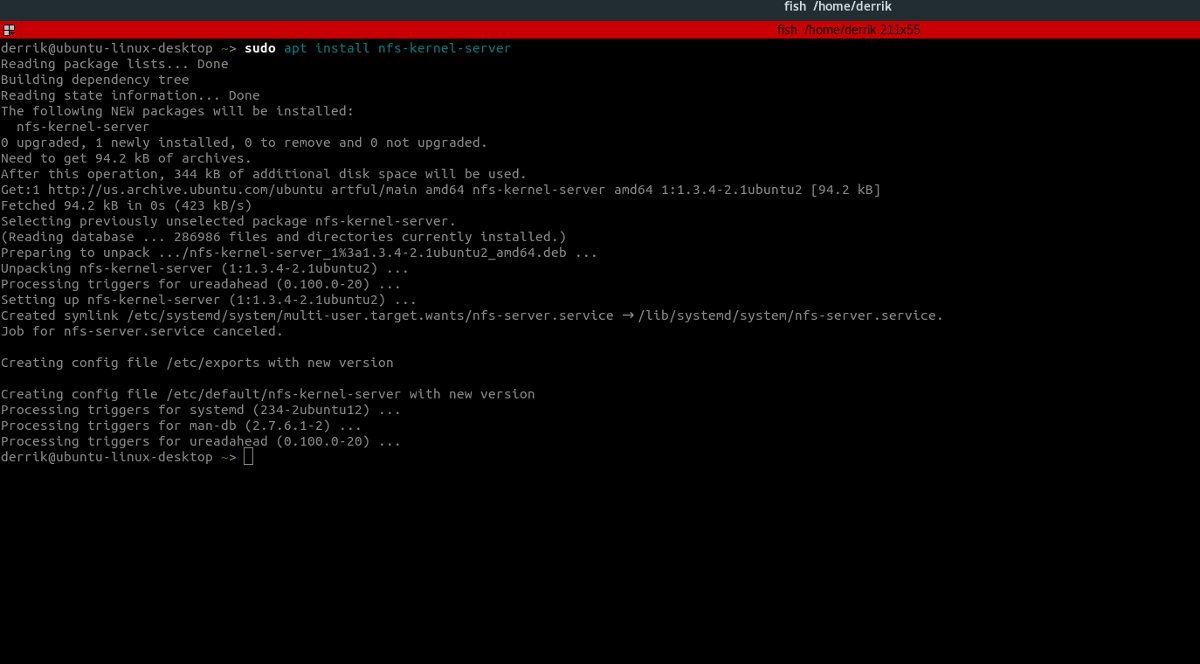For those who’re a reasonably expert Linux consumer, or a newbie with a server, the primary means you entry information is with Samba. Many do that due to how tough NFS seems to be. There’s so many steps, and little belongings you’ve received to get proper in comparison with one thing like Samba and even FTP. The truth that many Linux customers go over NFS is an actual disgrace, because it has lots of nice options and makes use of. That’s why we’ve determined to take the issue out of establishing an NFS server. We’ll break down how one can host NFS shares on Linux, and clarify it in depth how one can get a server up and operating
Set up

Typically, every Linux distribution has the identical NFS instruments with a number of variations right here and there. To get all the pieces working, open a terminal and set up the next packages to your system. These packages will set up the default know-how wanted to run the server, generate the default configuration information, and typically even configure different issues too.
Ubuntu
sudo apt set up nfs-kernel-server
Fedora
sudo dnf set up nfs-utils system-config-nfs
Arch Linux
sudo pacman -S nfs-utils
Debian
sudo apt-get set up nfs-kernel-server
OpenSUSE
sudo zypper set up nfs-kernel-server
Different Linuxes
The NFS file system, shopper, and server will not be new know-how. Because of this, you’ll simply be capable to get this engaged on just about any Linux distribution on the market. In case your working system wasn’t lined, think about looking for “nfs utils” within the bundle supervisor, or by referring to your working system’s Wiki.
Systemd providers
Establishing an NFS server could be totally different, relying on what Linux distribution you might be utilizing. For instance, if you happen to set up the Ubuntu or Debian NFS bundle, the systemd providers are robotically arrange and configured for you. Nevertheless, on one thing like Arch Linux, SUSE or Fedora and and so on, you’ll must do it manually. Right here’s how you can allow these providers.
For those who’re operating Arch Linux, Open SUSE or Fedora (or any Linux distribution that doesn’t robotically arrange the systemd providers for NFS) open up a terminal and enter these instructions.
sudo systemctl allow rpcbind
sudo systemctl allow nfs-server sudo service rpcbind begin sudo service nfs-server begin
Configuration
By putting in the NFS packages, the server is “set up”, however that doesn’t imply customers can entry it but. For this, customers must arrange exports, file areas, and so on. To begin off, achieve a root shell within the terminal. Do that with: sudo -s
The export file can deal with any kind of listing. Actually, customers can simply write out a direct location to a folder they want to share proper on the file system. The issue with that is that it’s a large safety danger. It’s a lot safer to take the contents of 1 listing and bind it to a different. This ensures that permissions for folders and directories within the /srv/ folder don’t have to be modified making all the pieces safe.
For instance, to arrange an NFS share of a consumer’s Photos folder, do the next:
mkdir -p /srv/nfs/footage /house/username/Photos/ mount --bind /house/username/Photos/ /srv/nfs/footage/
Use the instance above to make as many bind mounts as you’d like. Remember that it’s not required to mount directories from house folders. As a substitute use that instance and get artistic.
With all that sorted out, run these instructions to make the mounts stick:
echo '#NFS Photos Bind Mount' >> /and so on/fstab
echo '/house/username/Photos/ /srv/nfs/footage/ none bind 0 0' >> /and so on/fstab
Notice: you’ll want to vary the echo instructions to fit your personal mounts.
With the mounts arrange, it’s time to configure the exports configuration file. The exports file is essential, as that is the place you’ll must specify every file share for NFS to make the most of.
nano /and so on/exports
Contained in the export file, go all the best way to the underside, and write the next:
/srv/nfs/footage/ 192.168.0.0/255.255.255.0(rw,sync,no_subtree_check)
Be happy to jot down out as many strains as you need. Remember that every share wants its personal mount, fstab entry, and /and so on/exports entry.
Notice: save the exports file with CTRL + O
Updating Modifications
The NFS server is up and operating, the information are in the proper place, and all the pieces is able to use. The one factor left is to replace the adjustments made to the exports file. This is a vital step because the NFS server wont replace adjustments made whereas it’s operating. Do adjustments with: exportfs -rav
If want be, restart the server course of inside systemd itself through the use of the systemctl restart command.
sudo systemctl restart nfs-server.
Conclusion
The Community File System is a useful gizmo. With it, customers can simply take distant information and directories, and work with them regionally identical to a bodily onerous drive. That is nice, as competing community file system instruments don’t give customers the identical ubiquity and freedom.
Regardless of it’s usefulness, most individuals desire to make use of Samba as a substitute. That is comprehensible, as a result of in comparison with Samba, NFS generally is a bit annoying and tedious to arrange. Nevertheless, if you happen to take care of the tough setup course of, it’s way more value it.
